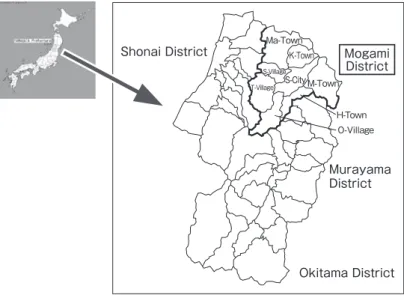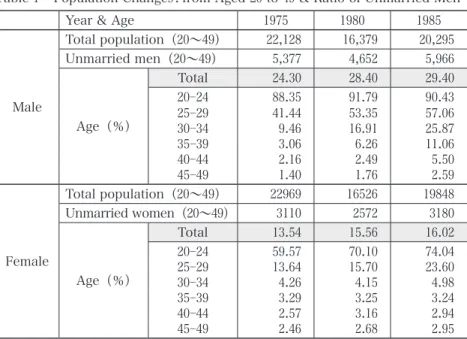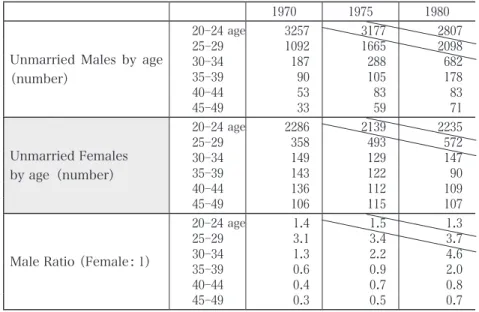Figure 1 Mogami District of Yamagata Pre.
O-Village
Farmers Successors and the Immigration
of Female Asian Spouses in Rural Japan
Shoji Okuyama
Purpose :
Over the past two decades in rural Japan there has been a dramatic increase in the number of marriages between middle-aged Japanese males and Asian female immigrants. The objective of this study is to document this trend in the rural district of Yamagata Prefecture and to investigate potential problems stemming from this newly emerging marriage pattern.
Methods :
(1)Geographical area: This research deals with Mogami District (County) in Yamagata Prefecture, which consists of one small
city, four towns, and three villages(See Figure 1).
(2)Comparison: This research analyzes the overall trends seen in the Japanese census data concerning unmarried men and women in an effort to compare and verify the data collected by field work.
(3)Field work: This research analyzes the data collected by field work interviewing bicultural couples in this rural area.
Hypothesis :
First it is necessay to clarify key concepts.
In 1953, Mataji Umemura, a professor emeritus of labor economics at Hitotsubashi University, classified the concept of labor relocation into two types to explain the changing circumstances in the labor supply, namely the life-cycle type and economic-cycle type of labor relocation(Umemura, 1953)
The life-cycle type of labor relocation is like the life-cycle from birth to death that proceeds continuously and regularly throughout life from employment to retirement. This is considered to imply steady supplies of labor because labor is an inevitable and normal function of life regardless of fluctuations in the labor market.
The economic-cycle type of labor relocation, on the other hand, is thought to be due to a labor force that floats between employment and unemployment workers who participate in the labor market as occasional laborers or as temporary and part-time workers.
Figure 2 Labor Market and Marriage Market in Rural Japan
The late Professor Umemura called the former the permanent labor force, and the latter the marginal labor force. In recent years, the marginal labor force has extended beyond national boundaries and become a globalized phenomenon in the world economy.
I think that these concepts of labor relocation give a hint towards explaining the nature of the marriage market in a rural area.
Let us call Japanese women the primary spouse candidates corresponding to the permanent labor force that the youth in the rural area choose as life-cycle bride candidates ; let us call Asian women the secondary spouse candidates corresponding to the
marginal labor force.
In recent years, the number of secondary spouse candidates has been increasing. In conjunction with economic changes after the high economic growth and the relative advantages and disadvantages of urban cities and rural areas how has this surge emerged ?
Table 1 Population Changes: from Aged 20 to 49 & Ratio of Unmarried Men and Women in Mogami District
Year & Age 1975 1980 1985 1990 1995 2000 2005 2005(nationwide)
Male Total population(20∼49) 22,128 16,379 20,295 19,046 18,649 16,850 14,519 25,222,395 Unmarried men(20∼49) 5,377 4,652 5,966 5,660 6,023 6,064 5,659 11,709,028 Age(%) Total 24.30 28.40 29.40 29.72 32.30 35.99 38.98 46.42 20―24 88.35 91.79 90.43 89.37 89.69 88.22 87.34 93.44 25―29 41.44 53.35 57.06 58.83 60.91 62.17 59.83 71.42 30―34 9.46 16.91 25.87 31.70 34.02 39.99 40.79 47.07 35―39 3.06 6.26 11.06 17.51 23.31 24.75 30.70 30.00 40―44 2.16 2.49 5.50 9.20 14.91 18.63 20.37 22.03 45―49 1.40 1.76 2.59 4.92 8.21 12.06 16.41 17.14 Female Total population(20∼49) 22969 16526 19848 18527 17790 16460 14476 24,705,347 Unmarried women(20∼49) 3110 2572 3180 3084 3235 3405 3319 8,736,677 Age(%) Total 13.54 15.56 16.02 16.65 18.18 20.69 22.93 35.36 20―24 59.57 70.10 74.04 77.20 78.16 78.30 76.68 88.70 25―29 13.64 15.70 23.60 31.10 36.75 42.96 42.96 59.02 30―34 4.26 4.15 4.98 7.78 12.62 17.15 21.56 31.97 35―39 3.29 3.25 3.24 3.86 5.08 8.63 11.28 18.38 40―44 2.57 3.16 2.94 2.96 3.35 4.49 7.51 12.06 45―49 2.46 2.68 2.95 2.81 2.89 3.37 4.31 8.21
Date: Japanese Census
Hypothetically, because the socio-economic status of rural areas is relatively lower than that of cities, many Japanese women in rural areas tend to migrate to urban cities. As a result, it becomes hard for young males in rural areas to find primary spouse candidates and they are likely to seek Asian females as secondary spouse candidates(Figure 2).
As the permanent labor force and the marginal labor force in the labor market become fluid due to business fluctuations, it is conceivable that the primary spouse candidates and the secondary spouse candidates become fluid due to changes in rural situations. In reference to this hypothetical framework, this research attempts to provide a partial understanding of this new trend in international marriages analyzing the census and other relevant statistical data at
Table 1 Population Changes: from Aged 20 to 49 & Ratio of Unmarried Men and Women in Mogami District
Year & Age 1975 1980 1985 1990 1995 2000 2005 2005(nationwide)
Male Total population(20∼49) 22,128 16,379 20,295 19,046 18,649 16,850 14,519 25,222,395 Unmarried men(20∼49) 5,377 4,652 5,966 5,660 6,023 6,064 5,659 11,709,028 Age(%) Total 24.30 28.40 29.40 29.72 32.30 35.99 38.98 46.42 20―24 88.35 91.79 90.43 89.37 89.69 88.22 87.34 93.44 25―29 41.44 53.35 57.06 58.83 60.91 62.17 59.83 71.42 30―34 9.46 16.91 25.87 31.70 34.02 39.99 40.79 47.07 35―39 3.06 6.26 11.06 17.51 23.31 24.75 30.70 30.00 40―44 2.16 2.49 5.50 9.20 14.91 18.63 20.37 22.03 45―49 1.40 1.76 2.59 4.92 8.21 12.06 16.41 17.14 Female Total population(20∼49) 22969 16526 19848 18527 17790 16460 14476 24,705,347 Unmarried women(20∼49) 3110 2572 3180 3084 3235 3405 3319 8,736,677 Age(%) Total 13.54 15.56 16.02 16.65 18.18 20.69 22.93 35.36 20―24 59.57 70.10 74.04 77.20 78.16 78.30 76.68 88.70 25―29 13.64 15.70 23.60 31.10 36.75 42.96 42.96 59.02 30―34 4.26 4.15 4.98 7.78 12.62 17.15 21.56 31.97 35―39 3.29 3.25 3.24 3.86 5.08 8.63 11.28 18.38 40―44 2.57 3.16 2.94 2.96 3.35 4.49 7.51 12.06 45―49 2.46 2.68 2.95 2.81 2.89 3.37 4.31 8.21
Date: Japanese Census
the macro, population level. I also undertook a survey interviewing couples in Mogami County where international marriages are prevalent.
Table 1 shows the changes in population and the percentage of un-married men and women aged 20 to 49 in the Mogami District from 1975 through 2005.
As the overall population in the Mogami District has increased over 30 years, the percentage of unmarried men among 20 to 49 years of age has gradually risen. However, unmarried men aged in their 30s and 40s, in particular, mark an especially high percentage. For in-stance, in 2005, while 11.28% of women 35 through 39 years old were unmarried, the unmarried men hit high of 30.70%. Furthermore, if we take a look at the 40―44 age bracket in 2005, we can see a clear
differ-Table 2 Populations Trends: Unmarried Females to Unmarried Males over time from 1970 to 2005
1970 1975 1980 1985 1990 1995 2000 2005
Unmarried Males by age (number) 20―24 age 3257 3177 2807 2221 1682 1949 1843 1600 25―29 1092 1665 2098 1981 1675 1379 1533 1360 30―34 187 288 682 1072 1085 979 903 968 35―39 90 105 178 448 711 798 689 656 40―44 53 83 83 159 367 598 627 546 45―49 33 59 71 85 140 320 469 529 Unmarried Females by age(number) 20―24 age 2286 2139 2235 1865 1588 1621 1479 1292 25―29 358 493 572 819 898 858 1003 925 30―34 149 129 147 190 268 360 404 497 35―39 143 122 90 114 147 173 243 256 40―44 136 112 109 88 101 126 152 206 45―49 106 115 107 104 82 97 124 143
Male Ratio (Female: 1)
20―24 age 1.4 1.5 1.3 1.2 1.1 1.2 1.2 1.2 25―29 3.1 3.4 3.7 2.4 1.9 1.6 1.5 1.5 30―34 1.3 2.2 4.6 5.6 4.0 2.7 2.2 1.9 35―39 0.6 0.9 2.0 3.9 4.8 4.6 2.8 2.6 40―44 0.4 0.7 0.8 1.8 3.6 4.7 4.1 2.7 45―49 0.3 0.5 0.7 0.8 1.7 3.3 3.8 3.7
*Data : Japanese Census
ential percentage of unmarried men and women -- the men account-ed for 20.37% and the women, 7.51%.
Many rural farming households in Japan are considerably wealthier than their salaried urban counterparts, and they often find the rural lifestyle quite attractive. Therefore, when economic conditions are favorable, most young women opt to remain in their rural communities; however, when there is an economic downturn, the number of rural females who decide to relocate to urban areas increases significantly. Consequently, in many rural communities, male successors who must continue the farming household have considerable difficulty finding suitable brides, particularly during an economic recession.
Table 2 Populations Trends: Unmarried Females to Unmarried Males over time from 1970 to 2005
1970 1975 1980 1985 1990 1995 2000 2005
Unmarried Males by age (number) 20―24 age 3257 3177 2807 2221 1682 1949 1843 1600 25―29 1092 1665 2098 1981 1675 1379 1533 1360 30―34 187 288 682 1072 1085 979 903 968 35―39 90 105 178 448 711 798 689 656 40―44 53 83 83 159 367 598 627 546 45―49 33 59 71 85 140 320 469 529 Unmarried Females by age(number) 20―24 age 2286 2139 2235 1865 1588 1621 1479 1292 25―29 358 493 572 819 898 858 1003 925 30―34 149 129 147 190 268 360 404 497 35―39 143 122 90 114 147 173 243 256 40―44 136 112 109 88 101 126 152 206 45―49 106 115 107 104 82 97 124 143
Male Ratio (Female: 1)
20―24 age 1.4 1.5 1.3 1.2 1.1 1.2 1.2 1.2 25―29 3.1 3.4 3.7 2.4 1.9 1.6 1.5 1.5 30―34 1.3 2.2 4.6 5.6 4.0 2.7 2.2 1.9 35―39 0.6 0.9 2.0 3.9 4.8 4.6 2.8 2.6 40―44 0.4 0.7 0.8 1.8 3.6 4.7 4.1 2.7 45―49 0.3 0.5 0.7 0.8 1.7 3.3 3.8 3.7
*Data : Japanese Census
Results :
The Japanese census confirms that in recent years the population of rural unmarried middle-aged males is increasing much more rapidly than the unmarried female population.
I wiill examine by cohort analysis about unmarried men to unmarried women in Mogami District from 1970 to 2005.
As Table 2 demonstrates, in 1995 within the 35 to 39 age-bracket, there were 4.6 unmarried rural males for every one unmarried rural female. In the year 2005, this figure was 3.7 for the 45 to 49 age-brack-et, indicating that rural middle-aged men were having considerable difficulty securing brides. Thus there has been a remarkable demand for Asian brides in Japanese rural communities. As Table 3 indicates foreigners by nationality and sex in Yamagata Prefecture and
nation-Table 3 Foreigners by Nationality and Sex in 2005(Yamagata Pre. & Nationwide)
%(numbers)
Korea China Philippines Others Total
Yamagata Male (331)17.4 (572)21.0 (28)4.3 (430)39.2 (1361)21.3 Female (1573)82.6 (2154)79.0 (629)95.7 (666)60.8 (5022)78.7 Total (1904)100.0 (2726)100.0 (657)100.0 (1096)100.0 (6383)100.0 Nationwide Male (213,046)45.7(138,611)40.0 (23,508)19.0(351,479)56.9 (726,644)46.7 Female(253,591)54.3(208,266)60.0 (100,239)81.0(266,765)43.1 (828,861)53.3 Total (466,637)100.0(346,877)100.0 (123,747)100.0(618,244)100.0 (1,555,505)100.0
souce:census,2005, Ministry of Internal Affairs and Communications, Japan
wide in 2005. Female immigrants outnumber male immigrants in Yamagata Prefecture, but nationwide male immigrants are at the same level as female immigrants except for immigrants from the Phil-ippines. It is clear that Asian females have came to Yamagata Prefec-ture for marriage to middle-aged farmers.
Also, Figure 3 indicated the number of bicultural marriages has increased 10-fold from a mere 40 in 1989 to 595 in 2005 such unions in Mogami alone. We are able to confirm that the vast majority of these Asian brides are coming to Japan from China, Korea, and the Philippines.
Discussion & Conclusions :
As you can see from this list of problems, I found that there were a number of common difficulties shared by many of these bicultural couples in the Mogami District. Perhaps the one problem that stands out the most is the sheer speed with which so many of these
Figure 3 The Number of Marriages in Mogami by Year & Nationality Source: District Office and Census.
marriages are arranged by Japanese marriage brokers.
Clearly, the immigration of Asian brides to Japanese rural communi-ties is a trend that seems very likely to only strengthen further in the coming years. In order to promote successful bicultural marriages in Japanese rural areas and to meet the needs of these young Asian women, we need to encourage a longer period of contact between the prospective spouses, so that both partners can have ample oppor-tunity to assess the chances of their marriage s success.(Figure 4 documents the high rate of divorce among these bicultural couples.) These problems the successors of farming households face affect not only themselves, but also local communities as a whole. In agriculture management based upon family business, even if there are successors, the household will become extinct without brides and
it will become impossible to continue agricultural farming. This directly leads to the decay of local communities.
In order to solve this crisis, a local government became a marriage broker for Asian women. The village of Asahi in the Murayama area was the first broker in 1985, and the village of Okura in Mogami in 1986 succeeded in making arrangements with Filipino females and brought ten brides in to the village(Kuwayama, 1995)
The marriages arranged by local governments expanded throughout Mogami County and the number of marriages increased from 40 in 1989 to 595 in 2005. The 16 years witnessed the rapid expansion of government-arranged marriages(Figure 3).
However, because the government s involvement was criticized as a promotion of a female slave trade, local governments withdrew from the business of marriage arrangement, and currently concentrate on developing an environment that encourages permanent residency of the foreign brides. Consequently, marriage to Asian females today has been arranged by private brokers.
Common Problems Related to International Marriages :
Based on my field work I could identify five major common problems related to international marriages many farming families encounter.
First of all, there is a problem with the quick arrangement of the marriage. The ordinary introduction of prospective partners starts with the exchange of their photographs and resumes. Once the mutual agreement is established, a Japanese male goes overseas to meet the prospective bride and both partners sign the marriage
agreement, register the marriage, finish the wedding ceremony, and the bridegroom comes back home alone.
The shortest process of marriage arrangement takes only eight days. Since it takes time to obtain an immigration visa, the bride comes to Japan two to three months later. In the meantime, the Japanese bridegroom prepares himself for his new foreign bride. According to a marriage broker with a high success rate arrangement, among other brokers I surveyed, both males and females have to fulfill certain conditions. As for the males, they are required to have certain assets, be healthy and display no tendency towards violence and alcohol abuse ; as for the females, they are required to take root as a bride of the farming family and to be able to give birth to children.
Because they stay together only for a short period of time before getting married, they are likely to face problems in their daily life when some cultural differences including the language barrier and traditional customs become issues.
Second, there are issues of children. There are more than 200 children born of international marriages in Mogami County.
With respect to the rearing of children there are conflicts between the Japanese families that want their first son to succeed to farming and the foreign wives who desire their children to be well educated. A mother-in-law who is conscious of preserving family traditions gives the first son(and grandson)special treatment. This also causes a problem with the foreign wives.
There are cases where these biased attitudes on the part of the Japanese family break up the marriage and foreign wives leave the
rural area. Even after they leave the area, the children are left behind as successors of the farming family. This portrays an aspect of the traditional family consciousness.
Third, there are problems in the daily life of foreign wives. Unless they obtain a driver s license, they are unable to establish friendships with local people or they lose friendships if there were any. They have to be able to read Japanese to pass a license test. Their language skill was poor to start with, and if they fail to obtain the driver s license, they cannot establish or expand friendships. Unless they expand friendships, they cannot improve their language skill. This is a vicious circle.
Furthermore, even though they become eligible to obtain Japanese citizenship after staying for five years, some wives decline to do so. If they are naturalized, they have to go through the process of applying for a visa to return to their native county. More than that, they seem to have a desire to keep their citizenship to escape to their native country if something intolerable happens. This is rooted in their deep anxiety about their life in Japan.
There is also an issue related to religion. When local events such as a fair or an athletic meet that community members participate in take a place on a Sunday, it is foreign wives priority to attend worship at church. Because they skip these community activities, they are severely criticized. It becomes an issue as to whether or not they visit the family s grave or pray even if they do visit. These seemingly minor cultural differences are encountered in daily life and can cause frictions.
Figure 4 Divorces Per 1000 Married Women in 1995 Source: Ministry of Health and Welfare
National Level Yamagata Pref.
Most of the income foreign wives earn working at a factory is taken away as a part of the family budget. Because a mother-in-law manages the budget, foreign wives who believe that the money they earn is theirs are dissatisfied with the management of the budget and they feel they are not properly respected.
Fifth, there is a high rate of divorce for married population. There are four types of relationships of husband and wife according to pop-ulation censuses : married , unmarried , widow/widower and
divorced . Divorce rates for married population can be obtained by dividing the number of divorces by married population classified by sex. Figure 4 indicates the rate of divorce per 1,000 married women(Figure 4).
The divorce rates of Japanese spouses and international marriages at the national level count are about 6‰ and 21‰, respectively. It is
clear that the divorce rate of international marriages is three times that of Japanese spouses. The divorce rate of Japanese spouses in Yamagata Prefecture in turn is approximately 3.67% which is lower than the national average. But the divorce rate of international marriages in Yamagata is as high as 54.37‰ which is 15 times the rate at the national level.
Of the 102 divorce cases I surveyed in Mogami 92‰, or 81 divorces or separations took place within the span of five years of marriage and about 70% of them were seen in less than two years. About 40% of divorces or separations at the national level occurred in less than five years.
These alarming rates of divorce or separation warn us that there are many serious problems with the arrangement of international marriages in the rural areas in particular.
What Is to Be Done :
Many foreign wives are living in rural areas as secondary spouses with many difficulties and Unhappiness as well.
In order to promote healthy local communities, it must be necessary to share different cultures through international marriages, to respond internationally and compassionately to the various issues at each level: individual, family, community, and governmental. References
Mataji Umemura(1960) (in
Japanese)(
Ministry of Health and Welfare(Statistics and Information Depart-ment, Minister s Secretariat,)
(2000)(in Japanese)
Statistics Bureau Ministry of Inlernd Affairs and Communications, ― ― (
). (in Japanese)Japan Immigration Association, Statistics on the Foreigners Registered in Japan, 2001 Institute of Population Problems, Ministry of Health and Welfare
(1993),
(in Japanese),(
)Toyo Keizui Shiposha. Kyoko Shakuya(1988)
(in Japanese)(
)Akashi-Shoten press.
Shuko Takeshita(2000) (in
Japa-nese)( )Gakubunsha press.
Norihiko Kuwayama(1995) (in
Japanese)( )Akashi Press.
付記:この研究は、科学研究費補助金(課題番号:18530452、研究期間 2006 ∼2008 年度)研究課題名:「東北農村におけるアジア系外国人妻の流入・生 活と高齢者の介護福祉問題」によって行われたものの一部である。








